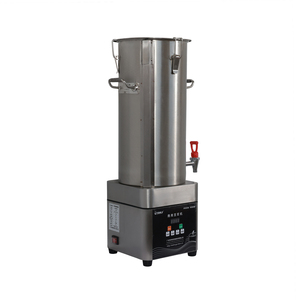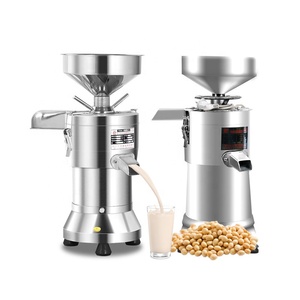(1324 products available)
































































































































































 Ready to Ship
Ready to Ship













































The soybean grinder is a kind of food processing equipment used for grinding soybeans. There are many types of soybean grinders. Generally speaking, they can be categorized into electric grinders, hand-cranked grinders, wet grinders, dry grinders, portable grinders, and high-capacity grinders.
Grinders differ in specifications according to the type and model. However, all grinders have similar specifications that help buyers compare different types and models.
Power source
The power source tells what powers the grinder. This can be electricity from an electric motor or fuel from a combustion engine. The specification may go ahead to indicate voltages, wattages, and other relevant details.
Power
The power of a soy milk grinder grinder tells the amount of energy the motor or engine produces. Sometimes, it can be indicated as horsepower or kilowatt. Grinder power affects the motor's ability to grind beans efficiently.
Capacity
The capacity of a soybeans grinder indicates the amount of beans the grinder can process during a specific time. It could be in kilograms per hour, liters, or tons per day.
Material
Most grinders are manufactured using stainless steel or food-grade steel. This ensures safety and durability.
Size
A grinder's size can be small, medium, or large. The actual dimensions are specified in length, width, and height in millimeters or inches. The size will depend on the capacity and design.
Sieve
A grinder with a sieve regulates the fineness of the processed material. Different sieve hole sizes will produce varying textural results.
Weight
Depending on the power and capacity, the grinder may weigh between 10 kg to over 2000 kg. The weight will impact the stability during grinding and overall utilization.
All mahcineries require a maintenance routine to keep them working and to extend their lifespans. Failure to maintain the grinder soy bean can lead to frequent breakdowns, reducing efficiency and increasing operating costs. Regular cleaning is the most important maintenance practice for a grinder machine. Assuming the grinder is made of stainless steel makes it even more important to clean it well to keep it safe.
Maintenance schedules should be developed based on usage hours or frequency. During the maintenance routine, operators should inspect the entire machine, identify any loose parts or damages, and then fix them. Lubricate any moving parts of the grinder. This minimizes wear and tear. For more demanding grinders, a professional servicing may become necessary from time to time. This should be done to avoid untimely breakdowns and maintain product warranties.
Due to its versatility in handling different types of grains and its varied applications, the soy bean grinder machine is a staple in many settings.
Home kitchens
In some regions, home kitchens use the grinder to make fresh soymilk, tofu, soybean paste, and other soybean products. It gives individuals greater control over the quality and flavor of their food.
Food processing companies
In the commercial food production industry, large-scale grinders are used to manufacture soymilk, tofu, soybean oil, sauces, and other soybean products for widespread distribution and sale. Workers can put in a large number of beans to be ground in a short amount of time, which will meet the needs of many consumers throughout the day.
Dairy alternative production facilities
Dairy alternative production facilities use soy grinders specifically designed for soybeans to produce soybean milk as a dairy alternative. The grinded beans will be processed further, like filtration and purification, to produce a final product for packaging and sale to supermarkets or other stores and retailers.
Tofu and soymilk stands/stalls
Tofu and soymilk stands/talls are small businesses that specialize in selling fresh tofu and soymilk products. Such establishments usually buy small- to medium-sized grinders that are easy to use and economically friendly to produce their offerings on-site, which attracts customers with the freshness of their products.
Restaurants and cafeterias
In the food service industry, grinders are used in restaurants, eateries, and cafeterias to prepare soybean-based dishes, sauces, and seasonings. Such facilities employ grinders with larger capacities, more stable performance, and more efficient processing speed.
Feed mills and animal farms
At feed mills and animal farms, soybeans serve as a primary source of protein in the animal diets, such as poultry, swine, cattle, and other livestock. The grinders assist in the preparation of soybean meal and other feed formulations, thus enhancing the nutrition and health of the farm animals.
Educational institutions
Some schools, colleges, and universities use soy grinders in their culinary programs or campus dining facilities. The grounds beans may be used for various educational purposes, including student training and experimentation with soybean products.
Nutritional supplement manufacturers
Nutritional supplement makers use grinders to process soy protein isolate and other soybean-derived nutritional supplements. These products are typically sold through dietary supplement retail stores or online channels.
Research and development laboratories
Food science and nutrition research and development laboratories use soybean grinders to prepare soybean-based experimental products for research, product development, or testing purposes. The grinders used in laboratories for experimental and product development purposes are usually more advanced and precise.
Grain mills
At grain processing facilities where various grains are handled, soybean grinders serve as an integral part of the processing line to produce soybean flour or soybean meal for further processing or incorporation into other grain-based products.
When choosing the suitable soy bean grinder for distinct needs, it's essential to consider a variety of factors.
Capacity and Volume:
The grinder's capacity and the number of soybeans it can process at once are crucial depending on business requirements. It is important to assess production demands, processing speed, and whether the grinder can meet them.
Powder Control:
The ability to grind soybeans into finer powder affects the texture and quality of the final product. Selecting a grinder that offers precise powder control allows adjusting the coarseness according to preferences and requirements.
Durability:
Investing in a durable grinder ensures its longevity and ability to withstand frequent use. Comparing different manufacturers helps choose one known for producing long-lasting machines.
Noise Level:
Grinding soybeans can be a noisy process. Considering the noise level of the grinder helps choose one that minimizes disruption and maintains a peaceful environment.
Ease of Use:
An easy-to-use grinder helps smooth operating and reduce training time for employees. Opting for a machine with clear instructions and an intuitive design simplifies the grinding process.
Cleaning and Maintenance:
Neglecting regular cleaning and maintenance can reduce processing efficiency. Choosing a grinder that offers hassle-free cleaning and maintenance helps businesses prioritize hygiene and equipment care.
Energy Efficiency:
Energy consumption impacts production costs. Selecting an energy-efficient soy bean flour grinder helps reduce environmental impact and contributes to sustainable business practices.
Overall Size:
The dimensions and weight of the grinder influence its placement and portability within the workspace. Considering the overall size helps determine if it fits well in the designated area.
Q1: What is the purpose of a soybean grinder?
A1: The purpose of the soy bean grinder is to finely grind the soybeans to produce soy milk. However, grinders can have different specifications to achieve different goals. Some grinders break down the soybeans to create soy milk and soy milk pulp, while others are used for the extraction of soy oil.
Q2: Can a soybean grinder be used for other grains?
A2: Many soybean grinders are manufacture to have multipurpose features. Therefore, it is possible for the grinder to grind other grains such as millet, rice, and corn. However, it is important to check the specifications of the grinder before confirming that it can grind different kinds of grains.
Q3: Does a soybean grinder come with additional parts?
A3: Depending on the seller or manufacturer, many grinders will come with additional accessories such as filters and strainers. These components can further facilitate the extraction process of soy milk. Some strainers and filters can be used to separate the soy milk from the soy milk pulp.
Q4: What are some of the advanced features of a soybean grinder?
A4: Some soy bean grinders will come with advanced features such as automatic feeding systems and temperature control settings. Moreover, separate grinders will have different specialized features. Buyers should always research the grinder they want to purchase to ensure it comes with the features they need.